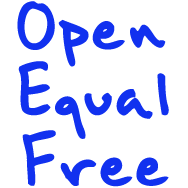The Open Content movement has incredible potential. We believe it has tremendous implications for education, as well as human life as we know it. It’s at the core of everything we do, and makes spreading great art, information, and education super easy.
Computers have added a new kind of resource to the world: data. What’s so special about data is that it is so easy to share inexpensively and without degradation. Now virtually any content can be made open and spread, and spread, and spread, without ever degrading in value; unless you’re trying to make money off of it.
To see the fascinating story of how the open content movement started, here’s a brief history. You can also follow these links to learn more about licensing, or just learn what Open Content is, exactly.
Before something can be opened, it must be closed.
Originally, copying the work of another author took an incredible amount of time and was limited to a handful of scribes scattered throughout medieval Europe. Indeed, an author was lucky to have his work read, let alone copied.
During the 15th and 16th century, however, the printing press began to spread widely throughout Europe allowing books to be produced for a tiny fraction of the expense and effort it once took. For the most part, both the church and governments of the time supported the spread of printing. After all, the printing press allowed the Bible and various pieces of government information to be produced and spread easily.
On the other hand, it also led to the propagation of works deemed undesirable by the powers that be. Thus, the governments of the time began restricting printers, requiring printers to have licenses in order to operate and/or print specific books. In 1557 the British Crown took their control a step further, creating the Stationers’ Company and limiting the right to print to members of that guild.
In 1694, the British Parliament chose not to renew the Stationers’ power, leaving a vacuum until April 10, 1710 when the Statute of Anne was enacted. Regarded as the first true copyright law, the statute was designed to encourage authors to write books by granting protections over their works.
From there, copyright grew into what it is today, a behemoth of restrictions and limitations that, for the most part, allows creators to determine how their work gets used and shared.
Enter Open Source Programing
The idea is simple. Behind every computer program is code, the instructions that make the computer program work. Open Source programs are programs where that code is available to users. So, even if you have to buy the program itself, you can still get access to, and modify, the code behind it. Some people consider the open source movement a philosophy, while others consider it to be simply a method of production.
Open source development, it has been argued, began before computer programming. Various industries, including the automotive industry, used collaborative networks to create new products. The movement really gelled, however, with computer programing. One of the earliest examples from the 1960′s is the Advanced Research Projects Agency Network, which used a process called Request for Comments that eventually led to the creation of protocols that one eventually grew into the Internet.
Coined by Christine Peterson, “open source” was used in describe Netscape’s 1998 announcement that it would release the source code for Navigator. The term began to spread rapidly, and today is used far more widely than its predecessor, “free software,” which doesn’t accurately describe the nature of many open source developments: The software may or may not be free, but the code is open and collaborative.
Open Content
Coined in the same year as “open source,” the term “open content” was used by David A. Wiley to describe a wider variety of content openly available to the public. Open Content is essentially any content that allows users to to do more with it than allowed under traditional copyright law.
The Open content movement has largely been connected to, and spread by, by Creative Commons. Founded in 2001, Creative Commons developed several licenses that make it easy for artists, writers, and other creators to make informed decisions about how and how much they want to share their works. As of last month, Flickr alone hosted 200 million Creative Commons licensed photos.
See the rest of our Free Media Guide for more info on how to license, find, and make the best open content!
Creative Commons Love: Maistora, -Tripp- , and Superbomba on Flickr.com
Written by Michael Jones



